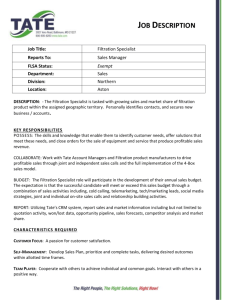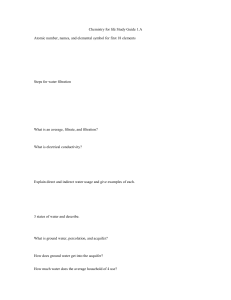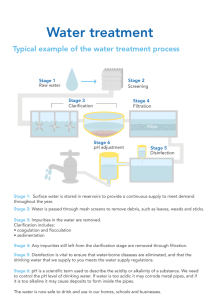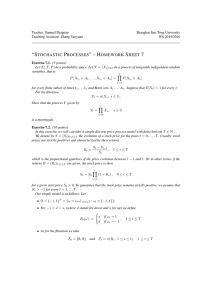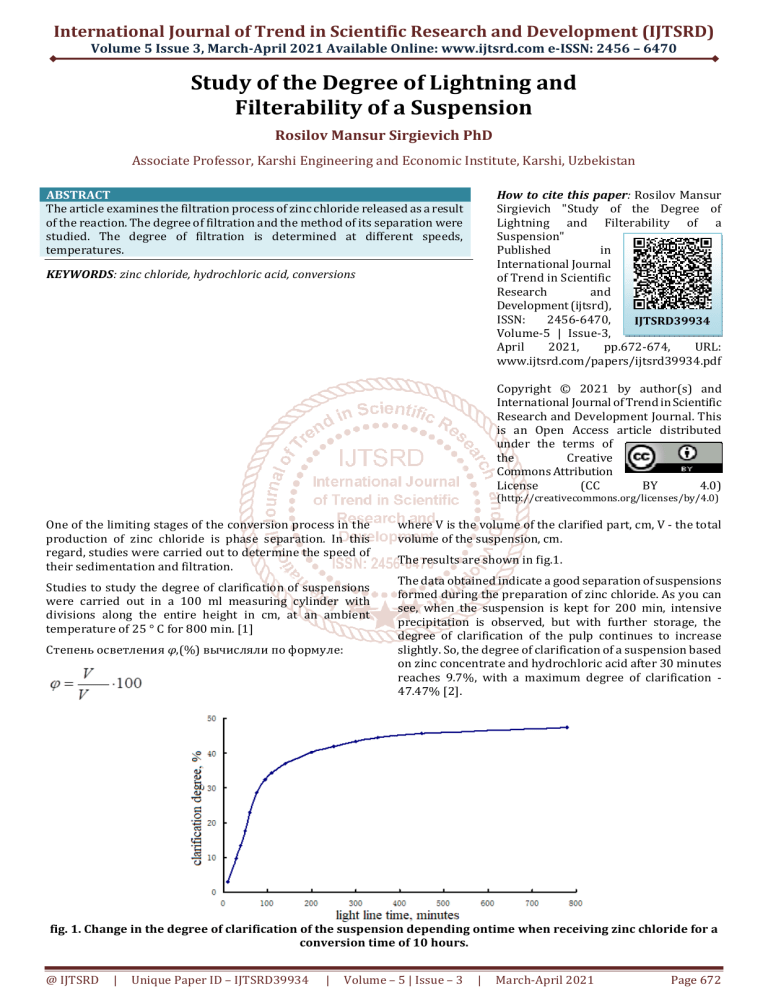
International Journal of Trend in Scientific Research and Development (IJTSRD) Volume 5 Issue 3, March-April 2021 Available Online: www.ijtsrd.com e-ISSN: 2456 – 6470 Study of the Degree of Lightning and Filterability of a Suspension Rosilov Mansur Sirgievich PhD Associate Professor, Karshi Engineering and Economic Institute, Karshi, Uzbekistan ABSTRACT The article examines the filtration process of zinc chloride released as a result of the reaction. The degree of filtration and the method of its separation were studied. The degree of filtration is determined at different speeds, temperatures. How to cite this paper: Rosilov Mansur Sirgievich "Study of the Degree of Lightning and Filterability of a Suspension" Published in International Journal of Trend in Scientific Research and Development (ijtsrd), ISSN: 2456-6470, IJTSRD39934 Volume-5 | Issue-3, April 2021, pp.672-674, URL: www.ijtsrd.com/papers/ijtsrd39934.pdf KEYWORDS: zinc chloride, hydrochloric acid, conversions Copyright © 2021 by author(s) and International Journal of Trend in Scientific Research and Development Journal. This is an Open Access article distributed under the terms of the Creative Commons Attribution License (CC BY 4.0) (http://creativecommons.org/licenses/by/4.0) One of the limiting stages of the conversion process in the production of zinc chloride is phase separation. In this regard, studies were carried out to determine the speed of their sedimentation and filtration. Studies to study the degree of clarification of suspensions were carried out in a 100 ml measuring cylinder with divisions along the entire height in cm, at an ambient temperature of 25 ° C for 800 min. [1] Степень осветления φ,(%) вычисляли по формуле: where V is the volume of the clarified part, cm, V - the total volume of the suspension, cm. The results are shown in fig.1. The data obtained indicate a good separation of suspensions formed during the preparation of zinc chloride. As you can see, when the suspension is kept for 200 min, intensive precipitation is observed, but with further storage, the degree of clarification of the pulp continues to increase slightly. So, the degree of clarification of a suspension based on zinc concentrate and hydrochloric acid after 30 minutes reaches 9.7%, with a maximum degree of clarification 47.47% [2]. fig. 1. Change in the degree of clarification of the suspension depending ontime when receiving zinc chloride for a conversion time of 10 hours. @ IJTSRD | Unique Paper ID – IJTSRD39934 | Volume – 5 | Issue – 3 | March-April 2021 Page 672 International Journal of Trend in Scientific Research and Development (IJTSRD) @ www.ijtsrd.com eISSN: 2456-6470 The rate of clarification of the suspension at the stage of obtaining zinc chloride is slow. But the experiments performed show that the products obtained are homogeneous, do not contain foreign impurities and thicken very well.[3]. Further, the filtration rates of the reaction slurry for the conversion of the zinc-containing concentrate with hydrochloric acid were determined in a vacuum filter unit. The main parameters that determine the filtration process are the resistivity of the sediment and the resistance of the filtering partition (fabric)[4]. The filtration rate was determined on a Buchner funnel, maintaining the vacuum in the Bunsen flask within 200-500 mm hg. art. fixing the filtration time. The filtering surface of the funnel is 0.005 m2. The calculation was carried out according to the formula: W= m ⋅ 3600 . S ⋅τ Table 1 shows the filtration rates of the suspension depending on the vacuum at the filtration stage.[2]. Table1 Influence of vacuum, temperature and height of the cake layer on the filter on the filtration rate Filtration rate, kg / m2 h № Vacuum, mmhg st. Temperature, ° С bypulp drydraft byfiltrate Suspension 20 119,64 49,65 69,99 200 40 130,40 54,11 76,29 1 60 139,40 57,85 81,55 20 143,04 59,02 84,02 300 40 158,70 65,86 92,84 2 60 176,15 73,10 103,05 20 183,23 76,04 107,19 3 400 40 199,72 82,88 116,84 60 217,69 90,34 127,35 20 230,68 95,73 134,95 4 500 40 251,44 104,34 147,10 60 274,07 113,73 160,34 R = 5 mm 20 121,58 50,45 71,13 5 300 40 132,52 54,99 77,53 60 144,44 59,94 84,50 R = 10мм 20 109,42 45,40 64,02 6 300 40 119,26 49,49 69,77 60 130,00 53,95 76,05 R = 15mm 20 98,47 40,86 57,61 7 300 40 107,33 44,54 62,79 60 116,99 48,55 68,44 The data on the filtration rate showed that the suspension, regardless of the degree of vacuum and temperature, is filtered well. The filtration rate for the suspension is 143.04– 176.15 kg / m2 · h at a discharge of 300 mm hg. art. An increase in the vacuum and temperature of the filtration process leads to an increase in the filtration rate for the pulp, filtrate and solid phase. So, increasing the vacuum in the flask from 200 mm Hg. Art. up to 500 mm Hg. Art. at a temperature of 20 ° C increases the rate of filtration through the slurry from 119.64 kg / m2 ∙ h to 230.68 kg / m2 ∙ h. An increase in temperature from 20 to 60 ° C with a vacuum of 200 mm hg. Art. increases the filtration rate for dry sediment from 49.65 kg / m2 ∙ h to 57.85 kg / m2 ∙ h. As can be seen @ IJTSRD | Unique Paper ID – IJTSRD39934 | from the data obtained, an increase in rarefaction has a greater effect on the filtration rate of a suspension than an increase in temperature.[5]. Studies of the filtration process were carried out at a constant vacuum of 300 mm Hg. Art. Filtration rates of suspensions increase with increasing temperature and amount to 143.04 - 176.15 kg / m2 ∙ h in terms of pulp. An increase in the height of the filter cake to 15 mm leads to a decrease in the filtration rate to 98.47 - 116.99 kg / m2 ∙ h for the pulp. Thus, the results of the pulp filtration study indicate the feasibility of separating the zinc concentrate slurry in a production environment. Volume – 5 | Issue – 3 | March-April 2021 Page 673 International Journal of Trend in Scientific Research and Development (IJTSRD) @ www.ijtsrd.com eISSN: 2456-6470 List of references [1] Safin D. Aspects of zinc production // Metal supply and sales. 2016. Issue. 6. S.46-51. [2] Rodionova I. A. Economic and social geography of the world. In 2 hours. Part 1: textbook for SPEO // Rodionova I. A. - 3rd ed., Rev. and add. - M.: Yurain Publishing House, 2018.S. 259-266. [3] Marchenko, NV Metallurgy of heavy non-ferrous metals [Electronic resource]: Electron. study. manual // N. V. Marchenko, E. P. Vershinina, E. M. @ IJTSRD | Unique Paper ID – IJTSRD39934 | Hildebrandt. - Elek-throne. Dan. Krasnoyarsk: IPK SFU, 2009. 9-15. (6 Mb). - [4] Babu, K. K. Sahu, B. D. Pandey Zinc recovery from sphalerite concentrate by direct oxidative leaching with ammonium, sodium and potassium persulphates // Hydrometallurgy. 2002.64. P. 119–129. [5] Yan Li, Anhuai Lu, Song Jin, Changqiu Wang, Photo reductive decolorization of an azo dye by natural sphalerite: Case study of a new type of visible light sensitized photo catalyst // J. Hazard. Mater. 2009.170. P479–486. Volume – 5 | Issue – 3 | March-April 2021 Page 674
